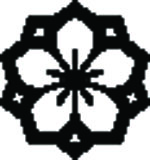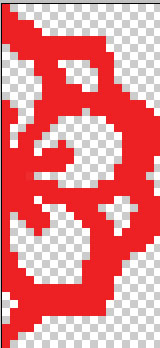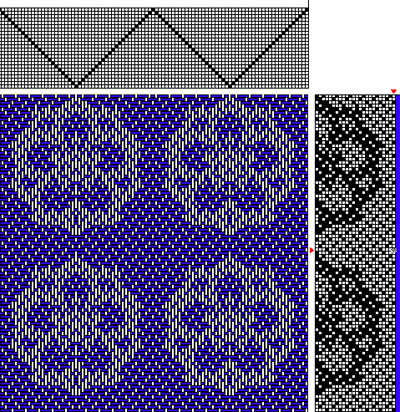Following the double-happiness draft, I started thinking of other things that could be done with Asian symbols. I remembered that I have a book full of Japanese heraldic crests, which are typically round in shape, stylized, and quite beautiful. Just the sort of thing that would work well in weaving!
Since I didn’t have the book with me (we fly home tomorrow), I went looking on the Internet, and found a site with lots of Japanese crests. (They are not copyrighted, so can be used freely.) I picked out this one:

It’s symmetric, so I could weave half of it on 24 shafts and use a point threading to create the second half.
Reserving four shafts to fill in spaces between the motifs, I shrank the image down to 40 pixels wide (twice times 20 shafts), and cut it in half:

Then I experimented with fills. I realized quickly that any pattern fill would be reversed when I used the point threading. I tried diagonal lines of twill, but the reversal in the middle of the symbol was very distracting. Satin would produce very long floats where the pattern reversed. So I finally settled on broken twills:

Because there are no strong diagonals, it could be reversed without calling too much attention to the reversals; because the max float length in a broken twill is 3, reversing it would produce only 5-thread floats, which at my usual sett is only about 1/8″.
So I saved the file as a .bmp, opened it as a sketchpad file in Fiberworks PCW, and cut and pasted from the sketchpad to the liftplan, producing this finished draft:

It’s a pretty draft, I hope to weave it up someday. Especially since it’s on a fairly simple threading, I could thread up with a point threading and try doing many different crests. I’d make them as Christmas gifts for the relatives, but I’m not sure how Chinese relatives would feel about getting Japanese crests, given the long history between China and Japan!
So far I haven’t done anything particularly advanced with the Woven Pixel techniques, but I hope to delve into the chapters on doubleweave someday. Perhaps once I get back!

IIRC from the textile displays I saw in Japan last spring, the patterning on the ultra-luxe/ultra-formal five-kamon kimon was done with a remarkably fine-tuned ikat technique that looked almost printed. There was also an extremely labor-intensive tie-dyeing process that was occasionally banned by sumptuary laws: kanoko shibori, which created itsy “fawn-spotted” patterns and which might actually be kinda interesting to create as a trompe d’oeil brocade.
Has anyone tried Escher-based reversibly-tiled brocade patterns?